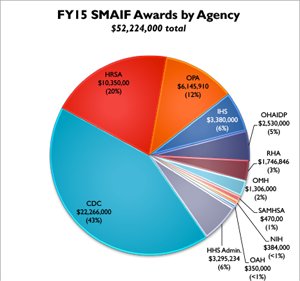FY’15 Secretary’s Minority AIDS Initiative Fund Awards
Content From: Ronald Valdiserri, M.D., M.P.H., Deputy Assistant Secretary for Health, Infectious Diseases, and Director, Office of HIV/AIDS and Infectious Disease Policy, U.S. Department of Health and Human Services•Published: October 21, 2015•6 min read
Topics

With Fiscal Year 2015 (FY15) just concluded, I wanted to share highlights of the awards made under the Secretary’s Minority AIDS Initiative Fund (SMAIF), which are supporting many activities that will unfold during FY16. A total of $52.2 million was awarded to support 31 initiatives across 10 HHS Operating Divisions (OpDivs) and Staff Offices to prevent new HIV infections and reduce drop-offs along the HIV care continuum for racial and ethnic minorities who bear a disproportionate burden of HIV disease.
These awards support activities including HIV testing, and linkage to and retention in HIV care, as well as efforts to strengthen capacity of communities and health systems to provide primary and secondary HIV prevention and HIV care. In all of these efforts, consistent with the priorities of the National HIV/AIDS Strategy: Updated to 2020, we have encouraged awardees to prioritize the geographic locations with substantial HIV burdens as well as the populations where HIV is most heavily concentrated.

Demonstration Projects
Approximately half of the FY’15 SMAIF resources were allocated to two demonstration projects involving the collaboration and support of several HHS OpDivs and offices. This includes $9.6 million to support the continuation of Partnerships for Care (P4C): Health Departments and Health Centers Collaborating to Improve HIV Health Outcomes, a three-year cross-agency demonstration project launched last year with an investment of SMAIF and Affordable Care Act resources. The project seeks to support the creation of sustainable partnerships among CDC-funded state health departments and HRSA-funded health centers to expand the capacity of community health centers, health departments, and their respective grantees to improve the identification of undiagnosed HIV infection, establish new access points for HIV care and treatment, and improve HIV outcomes along the continuum of care in communities highly affected by HIV, especially among racial/ethnic minorities. Four states are participating in this demonstration project: Florida, Maryland, Massachusetts, and New York. (Read about the 22 health centers that recently received funding to integrate highâ€quality HIV services into primary care through this demonstration.)In addition, $16.5 million in FY15 SMAIF resources were invested in a new four-year demonstration project led by CDC,Health Department Demonstration Projects for Comprehensive Prevention, Care, Behavioral Health, and Social Services for Men Who Have Sex with Men (MSM) of Color at Risk for and Living with HIV Infection. This investment supports state and local health departments to collaborate with community-based organizations, healthcare clinics and providers, behavioral health providers, and social service providers to develop comprehensive models of prevention, care, behavioral health, and social services for MSM of color living with or at risk for HIV acquisition. Health departments in seven jurisdictions received awards: Alabama, Baltimore, District of Columbia, Louisiana, New York City, Philadelphia, and Virginia. In addition, CDC awarded funds to Health HIV to offer technical assistance/capacity building assistance to the jurisdictions. The demonstration project requires the provision of 13 prevention services, including fourth generation HIV testing, PrEP assessment and adherence support, and assistance in enrolling in health coverage, as well as 11 care services including HIV primary care and retention interventions, re-engagement services, and linkage to behavioral health and social services.
Other Supported Activities Align with Strategy Priorities
The remaining $26.1 million of the FY15 SMAIF was allocated to a total of 28 awards ranging from $100,000 to $6.1 million. While much of this supports the continuation of activities initiated in recent years, 35% of the awards went to new initiatives that reflect principles and priorities of the Updated National HIV/AIDS Strategy. For example,- SMAIF resources were awarded to the Substance Abuse and Mental Health Services Administration (SAMHSA) to support efforts to reduce both interpersonal violence (IPV) and HIV through screening and referrals offered in behavioral health care settings by SAMHSA grantees. (The updated Strategy incorporates the objectives and recommendations of the Federal Interagency Working Group on the Intersection of HIV/AIDS, Violence against Women and Girls, and Gender-Related Health Disparities.)
- To support people living with HIV to remain in care or re-engage in care, the Indian Health Service received funds to enhance the use of medical informatics tools and adherence support to improve entry as well as re-engagement into care.
- In support of the updated Strategy’s call to make faster and better use of available data to inform program planning, FY15 SMAIF resources were awarded to the Health Resources and Services Administration (HRSA) to support the integration of housing and HIV health care data systems to facilitate a coordinated and comprehensive approach to HIV/AIDS housing, care and support services to homeless and unstably housed people living with HIV. (Read the Funding Opportunity Announcement .)
- Funds were awarded to CDC’ HIV/AIDS Division to support strategic partnerships and health marketing services for the Act Against AIDS Campaigns to provide communication tools for clinical and community-based providers serving transgender populations that will assist with reducing HIV acquisition for those at high risk who are HIV negative, increasing linkage and retention to care for transgender people living with HIV, and reduce stigma.
- Finally, through an award to CDC’s Division of STD prevention, SMAIF resources are supporting Evaluation of a Model to Deploy Disease Intervention Specialists (DIS) to Improve HIV Outcomes, an initiative that will evaluate the integration of activities that support various parts of the HIV prevention and care cascade into the routine STD prevention work of DIS in 4 sites. In each of the jurisdictions involved, select counties or cities with relatively high HIV rates and racial/ethnic minority population percentages will be involved in this evaluation project and MSM are a primary population that will be served.
